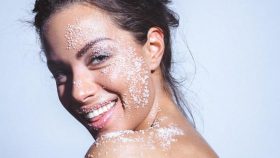5 beauty DIY mistakes you need to stop making
#3 is downright ridiculous, when you think about it.

Photo: iStock
The internet and social media has made keeping up with the latest in beauty trends more accessible for us all. Some vloggers and influencers make even the craziest of DIY trends look not only appealing and often pain free, but they also claim that the results can be much more effective than what is often the case.
While there are DIY beauty and skin care treatments that do work, most are just that trends and have no benefit to our skin or beauty routine while others can actually cause damage to your skin or result in serious injury if they go wrong. Either way, it’s time to let these ones go…
1.Using hairspray to set make-up
Don’t be fooled, hairspray was designed for hair and there is zero benefit to using it as a make-up setting spray! Hairspray contains alcohol and other unhealthy ingredients including polyvinyls and using it to set make-up can cause skin to dehydrate and dry out. It can cause skin irritations such as itchiness and redness as well as leave your make up feeling more sticky and shiny that dewy and glowy. If you’re using this regularly and suffer from repeated breakouts, odds are it’s the hairspray that’s causing it.
2. Cure breakouts with nappy rash cream
‘Smooth as a baby’s bottom’ is the aspiration of all of us women who want to achieve flawless skin but using diaper rash cream is not the answer. While the ingredients of nappy rash creams do help irritation suffered by babies like build ups of yeast, moisture and bacteria caused by diapers, not all of the ingredients are particularly helpful when applied to the face as skin care. Nappy balms are occlusive to the dermis, meaning they are designed to form a barrier to protect a baby’s delicate skin, and the base is too heavy for oily or acne-prone skin.
3. Using Milk of Magnesia as a primer under make-up
Yes, they are talking about the laxative and no, this does not work. This trend’s claim to fame is thanks to Kylie Jenner’s go-to make-up artist Hrush Achemyan who says to prep the youngest Kardashian-Jenner’s skin with it as it forms a layer between the skin and make-up, ensuring foundation doesn’t sink into the skin under the bright lights of photo shoots, or the 24/7 professional camera crew. In actual fact, Milk of Magnesia has a high pH that can damage our naturally slightly acidic skin as well as the acidic mantle that stops bacteria penetrating the skin. Damage to this acidic mantle allows for nasty bacteria to get past the skin’s natural defences, causing dry and acne-prone skin and ultimately potential damage to skin’s overall integrity.
4. At home chemical peels
Facial peels or derma-peeling are techniques professionals use to improve your skins texture and tone over time as well as assist with sun damage, pigmentation and breakouts. But the key word is “professionals”. Peels literally do cause your skin to peel and the strength of the peel determines the number of layers of skin peeled, length of downtime and the final result. There is a lot of misconception surrounding acid peel solution strengths, and it is dangerous to use anything that claims to be an at-home chemical peel.
When at-home chemical peels go wrong the results can range from unbearable pain to an increase in pigmentation, or even permanently scarred skin. Only use homecare cosmetic products that are formulated for daily or weekly use and leave chemical peels to the trained technicians who can supervise the treatment.
5. ‘Pain free’ sugar waxing
An ancient treatment favoured by the Pharaoh’s of Egypt? Some things are best kept in the past and sugar waxing is one of them. The “old-is-new” trendy way to remove hair cheaply and in the convenience of your own home has been popular amongst beauty columns and vloggers of late. While it’s a good for those who suffer from sensitive skin and the results are long lasting, sugar waxing is only effective for specific hair lengths and can cause skin inflammation, bacterial infections and serious burns to the skin if it’s not performed correctly.
SOURCE: My Body+Soul
Recent Posts

15 Style Moments We Constantly Think About From Confessions of a Teenage Drama Queen
Everett Collection / Buena Vista Pictures/Court...
14 Common Skin-Care Mistakes You Might Be Making, According to Dermatologists
Getty / Mint Images Getty Images/iStockp...
30 Ear Piercing Ideas That’ll Convince You to Curate Your Ear RN
Wait, you aren’t already curating your ear? Kid...
5 Breakout Haircut Trends to Wear This Season (Before Everyone Else)
Getty / Jeremy Moeller The itch to change it up...
The Latest Hair Trend? The Bubble Ponytail Is Back
Instagram @vildesaandvikReady for a nostalgia h...


